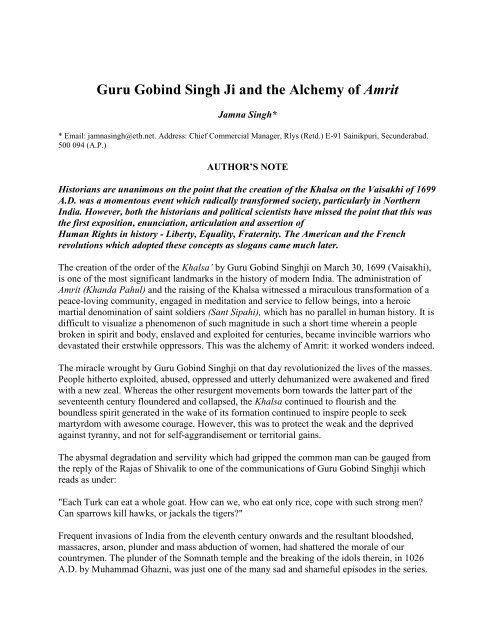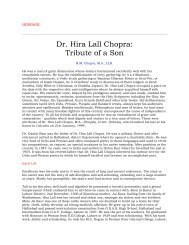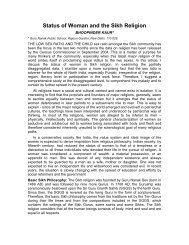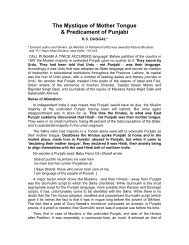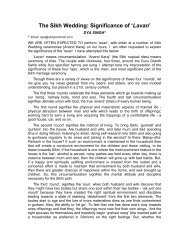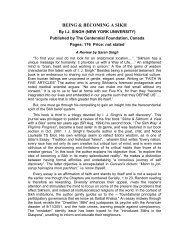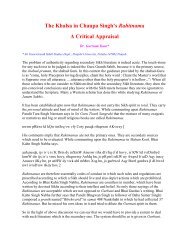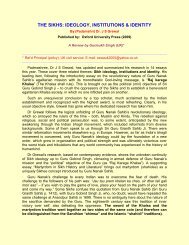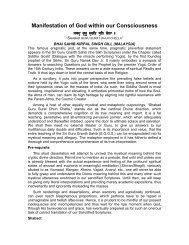Guru Gobind Singh Ji and the Alchemy of Amrit - The Sikh Review
Guru Gobind Singh Ji and the Alchemy of Amrit - The Sikh Review
Guru Gobind Singh Ji and the Alchemy of Amrit - The Sikh Review
Create successful ePaper yourself
Turn your PDF publications into a flip-book with our unique Google optimized e-Paper software.
<strong>Guru</strong> <strong>Gobind</strong> <strong>Singh</strong> <strong>Ji</strong> <strong>and</strong> <strong>the</strong> <strong>Alchemy</strong> <strong>of</strong> <strong>Amrit</strong><br />
Jamna <strong>Singh</strong>*<br />
* Email: jamnasingh@eth.net. Address: Chief Commercial Manager, Rlys (Retd.) E-91 Sainikpuri, Secunderabad.<br />
500 094 (A.P.)<br />
AUTHOR’S NOTE<br />
Historians are unanimous on <strong>the</strong> point that <strong>the</strong> creation <strong>of</strong> <strong>the</strong> Khalsa on <strong>the</strong> Vaisakhi <strong>of</strong> 1699<br />
A.D. was a momentous event which radically transformed society, particularly in Nor<strong>the</strong>rn<br />
India. However, both <strong>the</strong> historians <strong>and</strong> political scientists have missed <strong>the</strong> point that this was<br />
<strong>the</strong> first exposition, enunciation, articulation <strong>and</strong> assertion <strong>of</strong><br />
Human Rights in history - Liberty, Equality, Fraternity. <strong>The</strong> American <strong>and</strong> <strong>the</strong> French<br />
revolutions which adopted <strong>the</strong>se concepts as slogans came much later.<br />
<strong>The</strong> creation <strong>of</strong> <strong>the</strong> order <strong>of</strong> <strong>the</strong> Khalsa’ by <strong>Guru</strong> <strong>Gobind</strong> <strong>Singh</strong>ji on March 30, 1699 (Vaisakhi),<br />
is one <strong>of</strong> <strong>the</strong> most significant l<strong>and</strong>marks in <strong>the</strong> history <strong>of</strong> modern India. <strong>The</strong> administration <strong>of</strong><br />
<strong>Amrit</strong> (Kh<strong>and</strong>a Pahul) <strong>and</strong> <strong>the</strong> raising <strong>of</strong> <strong>the</strong> Khalsa witnessed a miraculous transformation <strong>of</strong> a<br />
peace-loving community, engaged in meditation <strong>and</strong> service to fellow beings, into a heroic<br />
martial denomination <strong>of</strong> saint soldiers (Sant Sipahi), which has no parallel in human history. It is<br />
difficult to visualize a phenomenon <strong>of</strong> such magnitude in such a short time wherein a people<br />
broken in spirit <strong>and</strong> body, enslaved <strong>and</strong> exploited for centuries, became invincible warriors who<br />
devastated <strong>the</strong>ir erstwhile oppressors. This was <strong>the</strong> alchemy <strong>of</strong> <strong>Amrit</strong>: it worked wonders indeed.<br />
<strong>The</strong> miracle wrought by <strong>Guru</strong> <strong>Gobind</strong> <strong>Singh</strong>ji on that day revolutionized <strong>the</strong> lives <strong>of</strong> <strong>the</strong> masses.<br />
People hi<strong>the</strong>rto exploited, abused, oppressed <strong>and</strong> utterly dehumanized were awakened <strong>and</strong> fired<br />
with a new zeal. Whereas <strong>the</strong> o<strong>the</strong>r resurgent movements born towards <strong>the</strong> latter part <strong>of</strong> <strong>the</strong><br />
seventeenth century floundered <strong>and</strong> collapsed, <strong>the</strong> Khalsa continued to flourish <strong>and</strong> <strong>the</strong><br />
boundless spirit generated in <strong>the</strong> wake <strong>of</strong> its formation continued to inspire people to seek<br />
martyrdom with awesome courage. However, this was to protect <strong>the</strong> weak <strong>and</strong> <strong>the</strong> deprived<br />
against tyranny, <strong>and</strong> not for self-aggr<strong>and</strong>isement or territorial gains.<br />
<strong>The</strong> abysmal degradation <strong>and</strong> servility which had gripped <strong>the</strong> common man can be gauged from<br />
<strong>the</strong> reply <strong>of</strong> <strong>the</strong> Rajas <strong>of</strong> Shivalik to one <strong>of</strong> <strong>the</strong> communications <strong>of</strong> <strong>Guru</strong> <strong>Gobind</strong> <strong>Singh</strong>ji which<br />
reads as under:<br />
"Each Turk can eat a whole goat. How can we, who eat only rice, cope with such strong men?<br />
Can sparrows kill hawks, or jackals <strong>the</strong> tigers?"<br />
Frequent invasions <strong>of</strong> India from <strong>the</strong> eleventh century onwards <strong>and</strong> <strong>the</strong> resultant bloodshed,<br />
massacres, arson, plunder <strong>and</strong> mass abduction <strong>of</strong> women, had shattered <strong>the</strong> morale <strong>of</strong> our<br />
countrymen. <strong>The</strong> plunder <strong>of</strong> <strong>the</strong> Somnath temple <strong>and</strong> <strong>the</strong> breaking <strong>of</strong> <strong>the</strong> idols <strong>the</strong>rein, in 1026<br />
A.D. by Muhammad Ghazni, was just one <strong>of</strong> <strong>the</strong> many sad <strong>and</strong> shameful episodes in <strong>the</strong> series.
<strong>The</strong> new breed <strong>of</strong> rulers <strong>and</strong> <strong>the</strong> ruling elite were generally fanatical <strong>and</strong> intolerant <strong>of</strong> <strong>the</strong><br />
indigenous Hindus. <strong>The</strong> socio-religious policy followed by <strong>the</strong> monarchs during <strong>the</strong> medieval<br />
period has been appropriately spelt out in <strong>the</strong> <strong>of</strong>t-quoted conversation between Allaudin Khilji<br />
<strong>and</strong> <strong>the</strong> Kazi on <strong>the</strong> point. According to <strong>the</strong> Kazi , "Hindus are like <strong>the</strong> earth, if silver is<br />
dem<strong>and</strong>ed from <strong>the</strong>m, <strong>the</strong>y ought with greatest humility <strong>of</strong>fer gold. And if a Mohammedan<br />
desires to spit into a Hindu’s mouth, <strong>the</strong> Hindu should open it wide for <strong>the</strong> purpose...." Allaudin<br />
Khilji’s response, that in that case he was following <strong>the</strong> correct policy, is indicative <strong>of</strong> <strong>the</strong> milieu<br />
prevailing in <strong>the</strong> medieval times. Rulers like Mohammad Tughlaq, Sher Shah Suri <strong>and</strong> Akbar<br />
were <strong>the</strong> exception, <strong>and</strong> not <strong>the</strong> rule.<br />
Throughout <strong>the</strong> pre- Mughal period <strong>and</strong>, again, during <strong>the</strong> reign <strong>of</strong> Aurangzeb, sustained efforts<br />
were made to convert <strong>the</strong> Hindus to Islam by persuasion, allurements <strong>and</strong> even terror. However,<br />
in Aurangzeb’s period, attempts at conversion to Islam became more vigorous, persistent <strong>and</strong><br />
systematic <strong>and</strong> <strong>the</strong> tortures <strong>and</strong> persecution surpassed all previous records. This was particularly<br />
so in Kashmir which was considered to be <strong>the</strong> bastion <strong>of</strong> Hinduism. Left with no o<strong>the</strong>r choice<br />
except death, or conversion to Islam, <strong>the</strong> Kashmiri p<strong>and</strong>its approached <strong>Guru</strong> Teg Bahadur Sahib,<br />
<strong>the</strong> ninth <strong>Sikh</strong> <strong>Guru</strong>, for solace, succour <strong>and</strong> advice. After listening to <strong>the</strong>ir tale <strong>of</strong> woes, <strong>the</strong><br />
<strong>Guru</strong> came to <strong>the</strong> conclusion that <strong>the</strong> mitigation <strong>of</strong> <strong>the</strong>ir plight called for <strong>the</strong> sacrifice <strong>of</strong> a pious<br />
man. <strong>Gobind</strong> Rai, <strong>the</strong> nine-year-old son <strong>of</strong> <strong>Guru</strong> Teg Bahadur, was present at <strong>the</strong> time. His<br />
spontaneous interjection at this point, that none o<strong>the</strong>r than <strong>the</strong> <strong>Guru</strong> was better suited for <strong>the</strong><br />
purpose, is <strong>of</strong> particular import in this saga <strong>of</strong> heroism. Here was a young lad prepared to<br />
sacrifice everything dear to him, including his venerable fa<strong>the</strong>r for a noble cause. <strong>Guru</strong> Teg<br />
Bahadur was greatly pleased at <strong>the</strong> reaction <strong>of</strong> <strong>Gobind</strong> Rai. He suggested to <strong>the</strong> Kashmiri p<strong>and</strong>its<br />
that <strong>the</strong>y should inform Aurangzeb that <strong>the</strong> Hindus all over India would willingly adopt Islam<br />
provided <strong>Guru</strong> Teg Bahadur gave up his faith <strong>and</strong> became a Muslim. This was accordingly done.<br />
When <strong>the</strong> Gum’s message was conveyed to Aurangzeb, he saw in it an opportunity to<br />
accomplish his cherished goal. <strong>Guru</strong> Teg Bahadur was summoned by Aurangzeb <strong>and</strong> was<br />
arrested while he was on his way to Delhi. When all efforts to convert him to Islam failed, he<br />
was beheaded on November 11, 1675 at Ch<strong>and</strong>ni Chowk in Delhi at <strong>the</strong> place where <strong>Guru</strong>dwara<br />
Sis Gunj st<strong>and</strong>s today.<br />
<strong>The</strong> <strong>Guru</strong>’s severed head <strong>and</strong> body lay for quite sometime <strong>and</strong> nobody dared to approach it for<br />
fear <strong>of</strong> death. However, sometime in <strong>the</strong> afternoon <strong>the</strong>re was a heavy dust storm accompanied by<br />
thunder <strong>and</strong> lightning, which scared away <strong>the</strong> sentries st<strong>and</strong>ing on guard. Taking advantage <strong>of</strong><br />
this, <strong>the</strong> head was picked up by a devout <strong>Sikh</strong> at great peril, <strong>and</strong> carried to An<strong>and</strong>pur Sahib for<br />
performing <strong>the</strong> last rites, whereas <strong>the</strong> body was carried away by ano<strong>the</strong>r equally devoted <strong>Sikh</strong><br />
<strong>and</strong> cremated at <strong>the</strong> place where <strong>Guru</strong>dwara Rakabgunj st<strong>and</strong>s.<br />
When <strong>Guru</strong> Teg Bahadur’s head was presented to <strong>Gobind</strong> Rai, who by <strong>the</strong>n had become <strong>the</strong><br />
<strong>Guru</strong>, <strong>and</strong> <strong>the</strong> conditions in which <strong>the</strong> revered head <strong>and</strong> body lay unclaimed for hours toge<strong>the</strong>r<br />
were narrated to him, he resolved to infuse his followers with unbeatable <strong>and</strong> indomitable<br />
courage <strong>and</strong> to give <strong>the</strong>m a distinct identity.<br />
<strong>The</strong> period between 1675 <strong>and</strong> 1699 was <strong>the</strong> preparatory period, which <strong>Guru</strong> <strong>Gobind</strong> <strong>Singh</strong>ji<br />
utilized for self-education, meditation <strong>and</strong> imparting intensive military training to his followers.
During this period, he composed great literary works <strong>and</strong> also fought several battles, <strong>of</strong> which<br />
<strong>the</strong> battle <strong>of</strong> Bhangni is <strong>the</strong> most significant. However, intensive military training, or writing <strong>of</strong><br />
powerful epics alone was not enough to reinvigorate a people who had been victims <strong>of</strong> passivity<br />
<strong>and</strong> pusillanimity, verging on slavery, for centuries toge<strong>the</strong>r. That called for innovation <strong>and</strong> full<br />
play <strong>of</strong> imagination <strong>of</strong> a superman <strong>of</strong> <strong>the</strong> stature <strong>of</strong> <strong>Guru</strong> <strong>Gobind</strong> <strong>Singh</strong>ji.<br />
<strong>The</strong> Vaisakhi <strong>of</strong> 1699 was chosen to accomplish this stupendous task <strong>and</strong> has become a<br />
l<strong>and</strong>mark in history. In <strong>the</strong> huge congregation which had assembled on this day, <strong>Guru</strong> <strong>Gobind</strong><br />
<strong>Singh</strong>ji asked for <strong>the</strong> head <strong>of</strong> a <strong>Sikh</strong> for <strong>the</strong> fulfilment <strong>of</strong> his mission. This sent shock waves<br />
among <strong>the</strong> people assembled, some <strong>of</strong> whom began to doubt <strong>the</strong> sanity <strong>of</strong> <strong>the</strong> <strong>Guru</strong>. However,<br />
five devoted <strong>Sikh</strong>s got up reverentially, one after ano<strong>the</strong>r, to comply with <strong>the</strong> wishes <strong>of</strong> <strong>the</strong> <strong>Guru</strong>.<br />
Blessed is <strong>the</strong> community that can throw up heroes ready to embrace death at <strong>the</strong> call <strong>of</strong> <strong>the</strong><br />
<strong>Guru</strong>!<br />
<strong>The</strong> <strong>Guru</strong> was overjoyed. He dressed <strong>the</strong> ‘blessed five’ in new robes <strong>and</strong> prepared kh<strong>and</strong>e di<br />
pahul (amrit) by stirring sweetened water with a double-edged dagger while reciting <strong>the</strong> holy<br />
hymns. He administered it to <strong>the</strong>m <strong>and</strong> ushered <strong>the</strong>m into <strong>the</strong> order <strong>of</strong> <strong>the</strong> Khalsa. This having<br />
been done, he requested <strong>the</strong>m to give <strong>Amrit</strong> to him in turn, <strong>and</strong> initiate him into <strong>the</strong> order <strong>of</strong> <strong>the</strong><br />
Khalsa.. Verily an elite company <strong>of</strong> supermen was created from ordinary mortals.<br />
<strong>The</strong> commonwealth <strong>of</strong> Khalsa was established. <strong>Guru</strong> <strong>Gobind</strong> <strong>Singh</strong>ji became both <strong>the</strong> <strong>Guru</strong> <strong>and</strong><br />
<strong>the</strong> disciple <strong>of</strong> <strong>the</strong> commonwealth. At a time when <strong>the</strong> equality <strong>of</strong> man was still a far cry, it is a<br />
tribute to his greatness that he submitted himself to <strong>the</strong> discipline <strong>of</strong> <strong>the</strong> Khalsa like any o<strong>the</strong>r<br />
<strong>Sikh</strong>, <strong>and</strong> became <strong>the</strong> first among <strong>the</strong> equals. Wah Wah <strong>Gobind</strong> <strong>Singh</strong> aapay gur chela (How<br />
wonderful <strong>Gobind</strong> <strong>Singh</strong> became both <strong>the</strong> <strong>Guru</strong> <strong>and</strong> <strong>the</strong> disciple). Those who had partaken <strong>of</strong> <strong>the</strong><br />
amrit lost <strong>the</strong>ir previous identity <strong>and</strong> became ‘singhs’ (lions)). Today all <strong>Sikh</strong> men <strong>and</strong> women<br />
have <strong>the</strong> suffix ‘<strong>Singh</strong> <strong>and</strong> Kaur, respectively with <strong>the</strong>ir names. Of <strong>the</strong> five ‘blessed ones’ who<br />
came to be addressed as <strong>the</strong> five beloved ones (punj piyaras), three belonged to <strong>the</strong> lower castes.<br />
However, all <strong>of</strong> <strong>the</strong>m became ‘<strong>Singh</strong>s’ <strong>and</strong> were equal after <strong>the</strong>y entered <strong>the</strong> order <strong>of</strong> <strong>the</strong> KhaIsa.<br />
"Recognise all human beings as <strong>the</strong> same (Manas ki jat sabhe ekke pehchanbo)," says <strong>Guru</strong><br />
<strong>Gobind</strong> <strong>Singh</strong>ji in his Akaal Utsat. Women, including those from <strong>the</strong> <strong>Guru</strong>’s family also partook<br />
<strong>of</strong> <strong>Amrit</strong>. Mata Sahib Kaur, <strong>the</strong> <strong>Guru</strong>’s wife got <strong>the</strong> title ‘Mo<strong>the</strong>r’ <strong>of</strong> <strong>the</strong> Khalsa because <strong>of</strong> her<br />
selfless devotion <strong>and</strong> dedication to <strong>the</strong> cause. <strong>The</strong> portrayal <strong>of</strong> mankind outlined in ‘Akaal Ustat’<br />
stressing on <strong>the</strong> fundamental unity <strong>and</strong> similarity <strong>of</strong> <strong>the</strong> human race, irrespective <strong>of</strong> caste, creed,<br />
language, religion, geographical locations, colour or sex was given a practical shape.<br />
<strong>The</strong> nectar or amrit alchemised <strong>the</strong> personality <strong>of</strong> <strong>the</strong> recipients. A new class <strong>of</strong> people was<br />
raised, a people who were prepared to ‘do or die’ <strong>and</strong> who were to usher in a new era; an era <strong>of</strong><br />
equality in which people could think freely, act freely <strong>and</strong> aspire to live with dignity. This was<br />
<strong>the</strong> first enunciation, exposition <strong>and</strong> assertion <strong>of</strong> Liberty, Equality <strong>and</strong> Fraternity in modern<br />
times. <strong>The</strong> American <strong>and</strong> <strong>the</strong> French Revolutions, which adopted <strong>the</strong>se concepts as slogans,<br />
came much later. But whereas people from all races, nationalities <strong>and</strong> communities, irrespective<br />
<strong>of</strong> colour or sex, could join <strong>the</strong> Order thus established. Liberty, Equality <strong>and</strong> Fraternity adopted<br />
by <strong>the</strong> French <strong>and</strong> American Revolutions applied only to <strong>the</strong> white man. Voltaire, <strong>and</strong> <strong>the</strong><br />
Contractualist philosophers <strong>of</strong> <strong>the</strong> seventeenth <strong>and</strong> eighteenth centuries whose writings had<br />
provided <strong>the</strong> <strong>the</strong>oretical basis <strong>and</strong> <strong>the</strong> inspiration for <strong>the</strong>se revolutions, never visualized <strong>the</strong>
human race in its entirety. "Man is born free but is everywhere in chains," lamented Rousseau,<br />
<strong>the</strong> more modern <strong>of</strong> <strong>the</strong> contractualists, in his magnum opus, ‘Social Contract’. But he too never<br />
thought <strong>of</strong> <strong>the</strong> plight <strong>of</strong> women <strong>and</strong> <strong>the</strong> Blacks. Interestingly, <strong>the</strong> Blacks in <strong>the</strong> o<strong>the</strong>rwise liberal<br />
American society had to wait for equal rights till President Abraham Lincoln issued <strong>the</strong><br />
Emancipation Proclamation in 1862 which was followed by <strong>the</strong> fifteenth amendment to <strong>the</strong><br />
federal constitution in 1870. Women in Europe had to wait till <strong>the</strong> twentieth century before <strong>the</strong>y<br />
were enfranchised.<br />
However, <strong>the</strong> Khalsa had to pay a heavy price in men <strong>and</strong> material to accomplish <strong>the</strong> goal. <strong>The</strong><br />
four sons <strong>of</strong> <strong>Guru</strong> <strong>Gobind</strong> <strong>Singh</strong>ji <strong>and</strong> his mo<strong>the</strong>r became martyrs for <strong>the</strong> cause. <strong>The</strong> atrocities<br />
committed on Mata Gujri <strong>the</strong> <strong>Guru</strong>’s mo<strong>the</strong>r, <strong>and</strong> her two younger sons at Sirhind before <strong>the</strong>y<br />
attained martyrdom are heartrending. However, <strong>the</strong> <strong>Guru</strong> remained resolute <strong>and</strong> unshaken in his<br />
conviction. He bore no malice towards <strong>the</strong> Muslim community to which, unfortunately, his<br />
perverse persecutors belonged. His faith in <strong>the</strong> Supreme benevolent God (Akalpurakh) <strong>and</strong> his<br />
conviction in <strong>the</strong> unity <strong>of</strong> <strong>the</strong> human race remained unshaken. ‘Maanas ki jat sabh ek hi<br />
pehchanbo’ (Recognize all human beings as <strong>the</strong> same) remained his motto till <strong>the</strong> last. Both <strong>the</strong><br />
Hindus <strong>and</strong> <strong>the</strong> Muslims continued to flock to him for spiritual guidance. <strong>The</strong> non-sectarian <strong>and</strong><br />
<strong>the</strong> unorthodox movement which started in <strong>the</strong> times <strong>of</strong> <strong>Guru</strong> Nanak Devji, <strong>the</strong> first <strong>Guru</strong>,<br />
reached its culmination under his stewardship. No words are adequate to describe <strong>the</strong> greatness<br />
<strong>and</strong> achievements <strong>of</strong> <strong>Guru</strong> <strong>Gobind</strong> <strong>Singh</strong>.. Voluminous documents eulogizing his deeds <strong>and</strong><br />
works cannot add an iota to his stature.<br />
However, it is only appropriate to remember such guru prophets reverentially, <strong>and</strong> make honest<br />
efforts to emulate <strong>the</strong>ir examples, which, apart from enriching <strong>the</strong> personality <strong>of</strong> <strong>the</strong> individuals,<br />
will go a long way in national reconstruction <strong>and</strong> national solidarity. Communities <strong>and</strong> nations<br />
that deliberately ignore <strong>the</strong>ir heroes, or pay only lip service to <strong>the</strong>m, suffer grievously <strong>and</strong> lose<br />
vitality. India <strong>and</strong> <strong>Sikh</strong>s have suffered on this count in <strong>the</strong> past. Let us not commit <strong>the</strong> same<br />
blunder hereafter.<br />
Charisma <strong>of</strong> <strong>Guru</strong> <strong>Gobind</strong> <strong>Singh</strong> <strong>Ji</strong><br />
Des Raj Narang*<br />
* Educated in Forman Christian College, Lahore, <strong>the</strong> octogenarian scholar has many research papers to his credit.<br />
Address: 602 Dr Mukherjee Nagar, New Delhi. 110 009.<br />
"<strong>The</strong>y are remarkably brave, superior in war to all Asiatics. <strong>The</strong>y are remarkable for <strong>the</strong>ir<br />
simplicity <strong>and</strong> integrity, so reasonable as never to have recourse to a law-suit, <strong>and</strong> so honest as<br />
nei<strong>the</strong>r to require locks to <strong>the</strong>ir doors nor writings to bind <strong>the</strong>ir agreements. No Indian was ever<br />
known to tell an untruth."<br />
This is <strong>the</strong> description <strong>the</strong> Greek historian <strong>and</strong> philosopher, Arrian, gives <strong>of</strong> <strong>the</strong> Indian character<br />
in ancient times.
India <strong>the</strong>n fell on evil days. Prolonged spells <strong>of</strong> subjugation to foreign rule subverted <strong>the</strong> moral<br />
<strong>of</strong> <strong>the</strong> people <strong>and</strong> caused unbelievable national deterioration. Words, such as Arrian’s, became<br />
<strong>the</strong> faint intimations <strong>of</strong> a remote, unreal past. But, centuries later, India exacted a tribute as<br />
magnificent as <strong>the</strong> one paid by Arrian <strong>and</strong>, in a way, even more significant.<br />
<strong>The</strong> latter-day attester is not a friend, but an enemy - Qazi Nur Muhammad - who came to India<br />
with Ahmad Shah Durrani’s seventh incursion into <strong>the</strong> country (1764-65) <strong>and</strong> was a witness to<br />
<strong>the</strong> <strong>Sikh</strong>s’ battles with <strong>the</strong> invader. In his poetic account, in Persian, <strong>of</strong> <strong>the</strong> Durrani’s invasion, he<br />
referred to <strong>the</strong> <strong>Sikh</strong>s in a rude <strong>and</strong> imprecatory language, but could not, at <strong>the</strong> same time, help<br />
proclaiming <strong>the</strong>ir many natural virtues. He said:<br />
‘Do not call <strong>the</strong>m "dogs" [his contumelious term for <strong>Sikh</strong>s] for <strong>the</strong>y are lions, <strong>and</strong> are courageous<br />
like lions in <strong>the</strong> field <strong>of</strong> battle. How can a hero, who roars like a lion in <strong>the</strong> field <strong>of</strong> battle, be<br />
called a dog? If you wish to learn <strong>the</strong> art <strong>of</strong> war, come <strong>and</strong> face <strong>the</strong>m in <strong>the</strong> field. <strong>The</strong>y will<br />
demonstrate it to you in such a way that one <strong>and</strong> all will praise <strong>the</strong>m for it... <strong>Singh</strong> is title [a form<br />
<strong>of</strong> address] for <strong>the</strong>m.. If you do not know <strong>the</strong> Hindustani language, I shall tell you that <strong>the</strong> word<br />
singh means a lion. Truly, <strong>the</strong>y are like lions in battle <strong>and</strong>, in times <strong>of</strong> peace, <strong>the</strong>y surpass Hatim<br />
in generosity.’<br />
‘Leaving aside <strong>the</strong>ir mode <strong>of</strong> fighting, hear yet ano<strong>the</strong>r point in which <strong>the</strong>y excel all o<strong>the</strong>r<br />
fighting people. In no case would <strong>the</strong>y slay a coward, nor would <strong>the</strong>y put an obstacle in <strong>the</strong> way<br />
<strong>of</strong> a fugitive. <strong>The</strong>y do not plunder <strong>the</strong> wealth <strong>and</strong> ornaments <strong>of</strong> a woman, be she a well-to-do<br />
lady or a maid-servant. <strong>The</strong>re is no adultery among <strong>the</strong>se "dogs"..... <strong>the</strong>y do not make friends<br />
with adulterers <strong>and</strong> house-breakers.’<br />
For a people engaged in a life-<strong>and</strong>-death struggle strictly to observe such scruples was pro<strong>of</strong> <strong>of</strong><br />
<strong>the</strong>ir extraordinary moral disciple. It seemed as if <strong>the</strong> gap <strong>of</strong> centuries had been made up. This<br />
resurrection <strong>of</strong> <strong>the</strong> national character was <strong>the</strong> result <strong>of</strong> <strong>the</strong> mircale wrought by <strong>Guru</strong> <strong>Gobind</strong><br />
<strong>Singh</strong>.<br />
<strong>The</strong> germ <strong>of</strong> this revolution lay in <strong>the</strong> Gospel <strong>of</strong> human dignity preached by <strong>Guru</strong> Nanak. <strong>Guru</strong><br />
<strong>Gobind</strong> <strong>Singh</strong> brought to culmination <strong>the</strong> process <strong>of</strong> regeneration which had been started. He<br />
restored to <strong>the</strong> people, freshly affranchised by <strong>the</strong> teachings <strong>of</strong> his predecessors, <strong>the</strong>ir spiritual<br />
certitude <strong>and</strong> <strong>the</strong>ir qualities <strong>of</strong> resoluteness <strong>and</strong> sacrifice, <strong>and</strong> revived <strong>the</strong>ir native energies.<br />
Judging from <strong>the</strong> cohesion he gave to <strong>the</strong> social fabric, <strong>and</strong> from <strong>the</strong> transcendent nature <strong>of</strong> his<br />
undertaking towards raising <strong>the</strong> plane <strong>of</strong> man’s thinking <strong>and</strong> action, <strong>Guru</strong> <strong>Gobind</strong> <strong>Singh</strong> ranks as<br />
<strong>the</strong> most constructive <strong>and</strong> charismatic genius in world history.<br />
<strong>Guru</strong> <strong>Gobind</strong> <strong>Singh</strong>’s Vision <strong>of</strong> <strong>the</strong> Saint-Soldier<br />
* Well-known broadcaster <strong>and</strong> educationist.<br />
Dr Maheep <strong>Singh</strong>*
<strong>Guru</strong> <strong>Gobind</strong> <strong>Singh</strong> had accepted armed resistance as <strong>the</strong> last resort. In his famous letter,<br />
Zafarnamah, to Emperor Aurangzeb, <strong>the</strong> <strong>Guru</strong> pointed out that he was not at all enamoured <strong>of</strong><br />
conflict <strong>and</strong> had accepted it as a painful necessity.<br />
He justified this step by saying when matters pass beyond all remedies, it is <strong>the</strong> right thing<br />
indeed to unsheath <strong>the</strong> sword. This was his vision regarding <strong>the</strong> war that he wanted his fellow<br />
countrymen to fight if <strong>the</strong>y wanted to save <strong>the</strong>ir honour <strong>and</strong> dignity.<br />
When he made his appearance on <strong>the</strong> scene, <strong>Guru</strong> <strong>Gobind</strong> <strong>Singh</strong> had before him a terrible picture<br />
<strong>of</strong> <strong>the</strong> country. He was called upon to save his people not only from <strong>the</strong> political bondage <strong>of</strong><br />
cruel tyrants, but also liberate <strong>the</strong> souls <strong>of</strong> men <strong>and</strong> women who had been demoralised to an<br />
unimaginable extent. It seemed clear that unless freedom - political <strong>and</strong> social - was won for <strong>the</strong><br />
poeple, it was difficult to rid <strong>the</strong> society <strong>of</strong> all <strong>the</strong> grave disabilities <strong>and</strong> exploitation that it<br />
suffered.<br />
At <strong>the</strong> age <strong>of</strong> nine, <strong>the</strong> <strong>Guru</strong> lost his fa<strong>the</strong>r, who was sacrificed in <strong>the</strong> fight for religious freedom.<br />
At that young, age, he was surrounded by a hostile <strong>and</strong> powerful empire. <strong>Guru</strong> <strong>Gobind</strong> <strong>Singh</strong><br />
emphasised on <strong>the</strong> moral approach to war that regards it as a means <strong>of</strong> perfecting individuals or<br />
society. He felt that people became virtuous by fighting for a just cause, which he called Dharma<br />
Yudh.<br />
After meditating intensely on <strong>the</strong> sad state <strong>of</strong> contemporary society, <strong>Guru</strong> <strong>Gobind</strong> <strong>Singh</strong> came to<br />
<strong>the</strong> conclusion that to tyrannise was bad, but to suffer tyranny was worse. He wasn’t dismayed,<br />
however. He knew that <strong>the</strong> human mind, when properly inspired, was capable <strong>of</strong> rising to <strong>the</strong><br />
l<strong>of</strong>tiest heights <strong>and</strong>, when rightly guided <strong>and</strong> controlled, could work wonders.<br />
He realised that he would have to depend entirely on his own resources. He set about planning<br />
<strong>and</strong> preparing himself for <strong>the</strong> struggle to win justice for his people. His army was to be based on<br />
<strong>the</strong> principle <strong>of</strong> social justice. <strong>The</strong>re could be no discrimination in <strong>the</strong> name <strong>of</strong> caste, creed <strong>and</strong><br />
colour. His soldiers, unpaid, ill-armed, poorly equipped <strong>and</strong> not so well-trained, were to be<br />
inspired by feelings <strong>of</strong> patriotism <strong>and</strong> nationalism.<br />
<strong>The</strong> <strong>Guru</strong>’s vision <strong>of</strong> war was based on <strong>the</strong> concept <strong>of</strong> <strong>the</strong> saint-soldier. <strong>The</strong> true soldier is a<br />
saintly person <strong>and</strong> a true saint is a mighty warrior. <strong>The</strong> hero is a seeker <strong>of</strong> truth. He wages<br />
a war in order that good <strong>and</strong> innocent people might live in peace <strong>and</strong> enjoy reasonable<br />
happiness.<br />
[Courtesy: <strong>The</strong> Hindustan Times]<br />
<strong>The</strong> Saint-Soldier Khalsa <strong>of</strong> <strong>Guru</strong> <strong>Gobind</strong> <strong>Singh</strong> <strong>Ji</strong><br />
* Vancouver, BC Canada.<br />
Gian <strong>Singh</strong> Kotli*, MA., LL.B.
It was on <strong>the</strong> 1st day <strong>of</strong> <strong>the</strong> month <strong>of</strong> Vaisakh in Indian Calendar, that <strong>Guru</strong> <strong>Gobind</strong> <strong>Singh</strong><br />
created <strong>the</strong> most amazing saint-soldier Khalsa by baptizing his followers in 1699. Hence it is<br />
called Vaisakhi or Baisakhi day. <strong>The</strong> instructions given on <strong>the</strong> occasion <strong>of</strong> ‘<strong>Amrit</strong>’ ceremony<br />
require description to explain <strong>the</strong> concept <strong>of</strong> saint-soldier Khalsa on <strong>the</strong> basis <strong>of</strong> <strong>the</strong> ideal <strong>of</strong> "first<br />
be willing to die, give up hope <strong>of</strong> living, be humble to all, <strong>the</strong>n come to me" contained in Sri<br />
<strong>Guru</strong> Granth Sahib. <strong>Guru</strong> <strong>Gobind</strong> <strong>Singh</strong> arranged an extraordinary large congregation. He<br />
appeared on <strong>the</strong> stage, seemingly in a very serious <strong>and</strong> ferocious mood with three-feet long<br />
shining sharp edged Kirpan in one h<strong>and</strong> challenged <strong>the</strong> ga<strong>the</strong>ring. "I want to test this Kirpan. Is<br />
<strong>the</strong>re any one who can give his head to me?" From <strong>the</strong> most stunned ga<strong>the</strong>ring stood up Bhai<br />
Daya Ram <strong>and</strong> <strong>of</strong>fered himself for <strong>the</strong> test. <strong>The</strong> <strong>Guru</strong> took him inside <strong>the</strong> back stage. A swish<br />
sound <strong>of</strong> cutting flesh was heard. <strong>The</strong> <strong>Guru</strong> performed this terrifying act four times more, with<br />
all <strong>the</strong> more dramatic dexterity, to select four more persons.<br />
But, after a few minutes, to <strong>the</strong> utmost surprise <strong>of</strong> all, <strong>the</strong> <strong>Guru</strong> presented all <strong>the</strong> five alive on <strong>the</strong><br />
stage nicely dressed alike. What transpired in <strong>the</strong> back tent is not known for certain. <strong>The</strong>se five<br />
were baptized with <strong>the</strong> specially prepared <strong>Amrit</strong> (Nectar <strong>of</strong> Immortality) by stirring double-edged<br />
Kh<strong>and</strong>a (a long straight dagger sharp from both sides) in it, while reading <strong>the</strong> holy hymns. <strong>The</strong>y<br />
were called Khalsa. Baptized persons were ordained to use <strong>the</strong> suffix <strong>of</strong> <strong>Singh</strong> (lion for males)<br />
with <strong>the</strong>ir names, <strong>and</strong> Kaur (princess) with <strong>the</strong> names <strong>of</strong> females. Thus Daya Ram became Daya<br />
<strong>Singh</strong> <strong>and</strong> <strong>Guru</strong> <strong>Gobind</strong> Rai became <strong>Guru</strong> <strong>Gobind</strong> <strong>Singh</strong> after taking initiation from <strong>the</strong> Five,<br />
whom he named Panj-Piare or Five Dear Ones. <strong>The</strong> Khalsa, <strong>the</strong> <strong>Singh</strong>, <strong>the</strong> Khalsa panth, <strong>the</strong><br />
bro<strong>the</strong>rhood <strong>of</strong> <strong>the</strong> pure ones, <strong>the</strong> fellowship <strong>of</strong> <strong>the</strong> pure ones, <strong>the</strong> beloved army <strong>of</strong> God, are<br />
largely synonymous terms. This is a common rhetoric that Khalsa was created out <strong>of</strong> <strong>the</strong> sharp<br />
edge <strong>of</strong> <strong>the</strong> double-edged Kh<strong>and</strong>a. It refers to this unique <strong>Amrit</strong> ceremony.<br />
<strong>The</strong> way <strong>the</strong> Khalsa was chosen clearly signifies death before death, voluntary death, death for<br />
righteousness, self-sacrifice for <strong>Guru</strong>, spiritual rebirth after temporal death <strong>and</strong> surrendering<br />
everything to <strong>Guru</strong>, including one’s life. This concept is quite in consonance with <strong>Sikh</strong> tenets<br />
<strong>and</strong> <strong>the</strong> concept <strong>of</strong> <strong>the</strong> perfectly pacifist saint <strong>Guru</strong> Nanak, who said, "If you want to play <strong>the</strong><br />
game <strong>of</strong> love (<strong>of</strong> God) <strong>the</strong>n come forward by placing your head on <strong>the</strong> palm <strong>of</strong> your h<strong>and</strong>." This<br />
clearly indicates that <strong>the</strong> light to show <strong>the</strong> path for <strong>the</strong> creation <strong>of</strong> saint-soldier Khalsa was lit by<br />
<strong>Guru</strong> Nanak. Still earlier Bhagat Kabir also says in Sri <strong>Guru</strong> Granth Sahib, "Only he is to be<br />
recognized as a valiant, who fights for righteousness <strong>and</strong> he may die, cut limb by limb, but never<br />
retreats from <strong>the</strong> battlefield." <strong>The</strong>refore, to be a saint, one must have unflinching faith in<br />
righteousness <strong>and</strong> to safeguard it he must be a valiant soldier.<br />
<strong>The</strong> sixth <strong>Guru</strong>, <strong>Guru</strong> Hargobind also enunciated <strong>the</strong> concept <strong>of</strong> Bhagti <strong>and</strong> Shakti (spiritual<br />
power <strong>and</strong> temporal power) which is quite akin to <strong>the</strong> concept <strong>of</strong> saint-soldier. After <strong>the</strong> pacifist<br />
self-sacrifice <strong>of</strong> his fa<strong>the</strong>r, <strong>Guru</strong> Arjun Dev for saving his religion, he wore two Talwars<br />
(swords) signifying that temporal power is essential for safeguarding righteousness. <strong>The</strong> ninth<br />
<strong>Guru</strong>, <strong>Guru</strong> Tegh Bahadur went still fur<strong>the</strong>r <strong>and</strong> did something most amazing <strong>and</strong> unprecedented<br />
in history, when he made <strong>the</strong> supreme sacrifice <strong>of</strong> his life, not for saving his own religion, but for<br />
saving <strong>the</strong> religion <strong>of</strong> <strong>the</strong> Hindus. <strong>The</strong>refore <strong>the</strong> creation <strong>of</strong> <strong>the</strong> Khalsa, who is perfectly an<br />
embodiment <strong>of</strong> a saint <strong>and</strong> a soldier, was a dire necessity <strong>of</strong> <strong>the</strong> times.
History has proved it that <strong>the</strong> credit goes to <strong>the</strong> saint-soldier <strong>Sikh</strong>s for facing <strong>and</strong> stopping <strong>the</strong><br />
attacks on India by foreign invaders like <strong>the</strong> Afghan ruler Ahmad Shah Abdali. A Persian<br />
scholar, qazi Nur Mohammad, was with Ahmad Shah Abdali during his seventh invasion <strong>of</strong><br />
India. He makes a most abusive remark about <strong>the</strong> <strong>Sikh</strong>s, yet unintentionally he also <strong>of</strong>fers a most<br />
appreciative <strong>and</strong> true tribute to <strong>the</strong> high character <strong>of</strong> <strong>the</strong> saint-solider <strong>Sikh</strong>s. He says in his book<br />
Jangnama, "Don’t call <strong>the</strong>se dogs, dogs. In fact <strong>the</strong>y are lions. In <strong>the</strong> battlefield <strong>the</strong>y are like<br />
brave lions. <strong>The</strong>y don’t attack <strong>the</strong> cowards <strong>and</strong> runaways from <strong>the</strong> battlefield, though <strong>the</strong>y may<br />
be <strong>the</strong>ir enemy. <strong>The</strong>y never disgrace women <strong>and</strong> never snatch <strong>the</strong>ir ornaments; she may be a<br />
maidservant or a queen. In <strong>the</strong> pack <strong>of</strong> <strong>the</strong>se dogs no one is a rapist <strong>and</strong> <strong>the</strong>y never commit a<br />
<strong>the</strong>ft."<br />
It will also be <strong>of</strong> great interest to <strong>the</strong> readers to know about some vows that are told to <strong>the</strong> pesons<br />
when <strong>the</strong>y are ‘baptized’. Apart from not cutting <strong>the</strong> hair, not using intoxicants <strong>and</strong> tobacco, <strong>the</strong>y<br />
are also told, "From today you have a new birth. You have joined Khalsa Panth. <strong>The</strong> name <strong>of</strong><br />
your spiritual fa<strong>the</strong>r is <strong>Guru</strong> <strong>Gobind</strong> <strong>Singh</strong> <strong>and</strong> your mo<strong>the</strong>r is Sahib Kaur <strong>Ji</strong> (<strong>Guru</strong> <strong>Gobind</strong><br />
<strong>Singh</strong>’s consort) your place <strong>of</strong> birth is Kesgarh Sahib (<strong>the</strong> Gurdwara in An<strong>and</strong>pur Sahib town,<br />
where <strong>Guru</strong> <strong>Gobind</strong> <strong>Singh</strong> ‘baptized’ <strong>the</strong> <strong>Sikh</strong>s in 1699) <strong>and</strong> you are resident <strong>of</strong> An<strong>and</strong>pur Sahib.<br />
Being <strong>the</strong> sons <strong>of</strong> <strong>the</strong> same fa<strong>the</strong>r, you all are bro<strong>the</strong>rs. By ab<strong>and</strong>oning your previous religion,<br />
caste, occupation, birth, country, you have become only Khalsa." For example, a person born in<br />
Vancouver becomes spiritually <strong>the</strong> resident <strong>of</strong> An<strong>and</strong>pur Sahib <strong>and</strong> <strong>the</strong> son <strong>of</strong> <strong>Guru</strong> <strong>Gobind</strong><br />
<strong>Singh</strong>.<br />
Is it not something very amazing? Is this idea not akin to one <strong>of</strong> <strong>the</strong> best dreams for promoting<br />
<strong>the</strong> idea <strong>of</strong> world village, world commonwealth, complete harmony, mutual underst<strong>and</strong>ing, love,<br />
<strong>and</strong> equality all over <strong>the</strong> world?<br />
* Email: sewauk@hotmail.com<br />
Kirpan - Its true import & significance<br />
Gurmukh <strong>Singh</strong> (UK)*<br />
Sr. Kashmir <strong>Singh</strong> <strong>of</strong> <strong>the</strong> Britiash <strong>Sikh</strong> Federation recently observed on UK’s Radio 4: "It is a<br />
God-given right for all persons to be able to defend <strong>the</strong>mselves, with upto date arms. It is a<br />
Constitutional Right in <strong>the</strong> USA for all its citizens to bear fire-arms (guns); it is a requirement in<br />
Switzerl<strong>and</strong> for all its able bodied citizens to keep fire-arms <strong>and</strong> ammunition at home, as part <strong>of</strong><br />
national defence, <strong>and</strong> to take part in regular training <strong>and</strong> war games (Hola Mohalla as started by<br />
<strong>Guru</strong> <strong>Gobind</strong> <strong>Singh</strong>), in order to keep <strong>the</strong>ir<br />
skills up to date. No country has dared to attack Switzerl<strong>and</strong> for hundreds <strong>of</strong> years, because all<br />
it’s citizens are soldiers, e.g. Nazi Germans or <strong>the</strong> Soviet Union did not dare to attack."<br />
What Sr. Kashmir <strong>Singh</strong> writes, reminds me to say something I have been<br />
meaning to say for some time about <strong>the</strong> <strong>Sikh</strong> Kakars. <strong>Guru</strong> <strong>Gobind</strong> <strong>Singh</strong> <strong>Ji</strong> formalised <strong>the</strong> 5 Ks<br />
for <strong>the</strong> Khalsa from Vaisakhi 1699, although, <strong>the</strong>se had already become part <strong>of</strong> <strong>the</strong> <strong>Sikh</strong> way <strong>of</strong>
life since <strong>Guru</strong> Hargobind <strong>Ji</strong>, who<br />
addressed <strong>the</strong> <strong>Sikh</strong>s as his Khalsa in his Hukamnamas. (I make my point about <strong>the</strong> Kirpan in <strong>the</strong><br />
final paragraph - it is an important point, especially for <strong>the</strong> young Khalsa today, more so after <strong>the</strong><br />
events following 11th September, <strong>and</strong> <strong>the</strong> goings on in Leeds, etc.)<br />
<strong>The</strong> <strong>Sikh</strong> way <strong>of</strong> life - maryada - evolved over 200 years, from <strong>Guru</strong> Nanak Sahib to <strong>Guru</strong><br />
<strong>Gobind</strong> <strong>Singh</strong> <strong>Ji</strong>. It is almost certain that due to <strong>the</strong> close connection - synergy - became natural<br />
(sabat surat) human form <strong>and</strong> a spiritual disposition, most devoted <strong>Sikh</strong>s kept <strong>the</strong>ir hair unshorn.<br />
Most bhagats or holy men, who preached life affirming ideologies, almost certainly kept <strong>the</strong>ir<br />
hair tidy <strong>and</strong> unshorn, i.e. not matted like <strong>the</strong> drop-out, opt-out yogis who were not householders.<br />
That invariably meant keeping a h<strong>and</strong>y comb to keep <strong>the</strong>m tidy.<br />
Few who wielded <strong>the</strong> sword alongside <strong>Guru</strong> Hargobind <strong>Ji</strong> would have worn <strong>the</strong><br />
loose dhoties but <strong>the</strong> traditional warrior shorts, <strong>the</strong> Kacchera which ancient warriors in India<br />
wore, e.g., you do not see mythical warriors depicted in pictures, like Hanuman, wearing loose<br />
dhotis but versions <strong>of</strong> agile kaccheras.<br />
Again, nothing novel about warriors wearing iron bracelets (kara) on <strong>the</strong>ir arms. Just look at<br />
some old drawings <strong>of</strong> <strong>the</strong> Akalis or Nihangs. Not one Kara but several karas on both arms.<br />
(Chakars - quoits over dastars <strong>and</strong> karas on arms). Iron karas were always worn by ancient<br />
warriors. <strong>The</strong> sword, <strong>the</strong> purpose <strong>of</strong> which <strong>Guru</strong> <strong>Ji</strong> made clear by renaming it "kirpan" (<strong>the</strong><br />
"benevolent protector <strong>of</strong> honour") was almost certainly always carried or worn by many <strong>Sikh</strong>s<br />
decades before <strong>the</strong> Vaisakhi day in 1699.<br />
Indeed <strong>Guru</strong> Hargobind <strong>Ji</strong> referred to his <strong>Sikh</strong>s as his Khalsa in his Hukamnamahs. It was a term<br />
signifying direct attachment with <strong>the</strong> <strong>Guru</strong>. No intermediaries, <strong>the</strong> mas<strong>and</strong>s <strong>and</strong> scholarly<br />
preachers, sent out by <strong>the</strong> <strong>Guru</strong>s had any right to <strong>the</strong> devotion <strong>of</strong> <strong>the</strong> <strong>Sikh</strong>s. In <strong>Sikh</strong>ism, Khalsa<br />
must always be interpreted in that direct "<strong>Guru</strong>-<strong>Sikh</strong>" relationship <strong>and</strong> no o<strong>the</strong>r. "Khalsa" is a<br />
l<strong>and</strong> law term used for <strong>the</strong> sovereign’s own personal l<strong>and</strong> (as opposed to l<strong>and</strong> given to<br />
subservient nawabs, rajahs, jagirdars, etc under <strong>the</strong> feudal sytem, i.e. l<strong>and</strong>s held in fee). So<br />
Khalsa is <strong>of</strong> <strong>the</strong> <strong>Guru</strong>, <strong>the</strong> <strong>Guru</strong>, <strong>the</strong> Enlightener ultimately is <strong>the</strong> True <strong>Guru</strong>, Akal Purakh. So <strong>the</strong><br />
Khalsa is <strong>of</strong> Waheguru, "Waheguru <strong>Ji</strong> ka Khalsa" <strong>and</strong> <strong>the</strong> ultimate victory is also <strong>of</strong> <strong>the</strong> <strong>Guru</strong>,<br />
"Waheguru <strong>Ji</strong> Ki Fateh."<br />
<strong>The</strong> five Ks are not ‘symbols’. <strong>The</strong>y are more than "articles <strong>of</strong> faith": <strong>the</strong>y are an essential<br />
part <strong>of</strong> <strong>the</strong> Khalsa’s way <strong>of</strong> life made m<strong>and</strong>atory by <strong>Guru</strong> <strong>Gobind</strong> <strong>Singh</strong> <strong>Ji</strong>.<br />
Returning to my main point: <strong>The</strong> Khalsa‘s Kirpan is an "extension" <strong>of</strong> <strong>the</strong> physical human body<br />
<strong>and</strong> <strong>the</strong> invisible/invincible human spirit - <strong>the</strong> focus <strong>and</strong> focal point <strong>of</strong> a <strong>Sikh</strong>’s physical <strong>and</strong><br />
spiritual (miri-piri, in that order) energy. Only to that extent is it a "symbol". If, at any age, I<br />
cannot feel that I can take on with confidence any being who is attacking those I am entrusted to<br />
defend (including my own honour) <strong>the</strong>n I have failed my <strong>Guru</strong>. A kirpan weighs over a kilo, can<br />
I wield it, swing it around at speed with <strong>the</strong> right footwork? - if not ,why not? Did Baba Deep<br />
<strong>Singh</strong> <strong>Ji</strong>, at 70 years plus, not swing <strong>the</strong> mighty double-edged sword in battle? <strong>The</strong>re must be a<br />
good reason, o<strong>the</strong>rwise I have failed my <strong>Guru</strong>’s instruction to be "Tiar barr tiar Khalsa."
So, Khalsa <strong>Ji</strong>, please do not let <strong>the</strong> Kirpan become just a symbol or even an article <strong>of</strong> faith for<br />
display - it may be both but it is a real weapon <strong>of</strong> defence. When it is taken away from me, it is<br />
still <strong>the</strong>re in my spiritual h<strong>and</strong> (yes, <strong>the</strong>n perhaps a symbol or an article <strong>of</strong> faith only) on which I<br />
focus, but <strong>the</strong> rest <strong>of</strong> <strong>the</strong> body <strong>and</strong> mind are still <strong>the</strong>re! So let no<br />
<strong>Sikh</strong> ever feel "unarmed" or without a "kirpan", when <strong>the</strong> combination <strong>of</strong> a strong agile body <strong>and</strong><br />
an invincible spirit is <strong>the</strong>re. That requires daily exercise <strong>and</strong> practice <strong>of</strong> self-defence movements.<br />
<strong>Sikh</strong> centres, like those maintained by <strong>the</strong> <strong>Guru</strong> Sahiban from <strong>Guru</strong> Angad Dev <strong>Ji</strong> onwards, must<br />
ensure proper training/exercise facilities.<br />
We should fight <strong>the</strong> legal battle for a <strong>Sikh</strong>’s religious right to wear a Kirpan, but we must always<br />
strive not to part with <strong>the</strong> "kirpan" <strong>of</strong> body/mind combination as sant-sipahis <strong>of</strong> <strong>the</strong> <strong>Guru</strong>. <strong>The</strong><br />
art <strong>of</strong> gatka for h<strong>and</strong>/body movements is our great heritage; all <strong>Sikh</strong><br />
children should learn it <strong>and</strong> never feel defenceless under any circumstance.<br />
Wearing <strong>the</strong> kirpan <strong>of</strong> <strong>the</strong> <strong>Guru</strong> would be true homage to "Kirpan", <strong>the</strong> gift <strong>of</strong> <strong>the</strong> <strong>Guru</strong>. We<br />
know what we faced in <strong>the</strong> streets <strong>of</strong> <strong>the</strong>se countries when we arrived in <strong>the</strong> early nineteen<br />
sixties. In 1984, were <strong>the</strong> <strong>Sikh</strong>s <strong>of</strong> Delhi wearing <strong>the</strong>ir "kirpans" when <strong>the</strong>y were caught <strong>and</strong><br />
burnt alive? So, are you wearing your "kirpan" today, or is it just a symbol <strong>and</strong> an article <strong>of</strong> faith<br />
for show?<br />
* Email: dakhalsa@aol.com<br />
<strong>The</strong> Cult <strong>of</strong> "Nihang <strong>Singh</strong>s"<br />
Kanvar Ranvir <strong>Singh</strong>*<br />
Legend has it that <strong>Sikh</strong>s under stress in <strong>the</strong> eighteenth century created <strong>the</strong> Order <strong>of</strong> Nihang<br />
"<strong>Singh</strong>s" - in order to counteract <strong>the</strong> imperialist Mughals, in particular to stop <strong>the</strong> abduction <strong>of</strong><br />
young Indian girls taken away by invaders to Persia <strong>and</strong> Afghanistan to be sold as slaves.<br />
Apart from a neat allegory typical <strong>of</strong> <strong>the</strong> jung boli (war language) <strong>of</strong> <strong>the</strong> time, <strong>the</strong> selection <strong>of</strong> <strong>the</strong><br />
"crocodile," <strong>the</strong> ultimate ambush-predator may indicate something <strong>of</strong> <strong>the</strong> nature <strong>of</strong> <strong>the</strong> <strong>Sikh</strong> art <strong>of</strong><br />
war against evil impulses.<br />
Nihang, <strong>the</strong> crocodile, is not a hungry beast, since it needs only one meal in a year to survive; its<br />
stomach is only <strong>the</strong> size <strong>of</strong> a human head. It only shows 1% <strong>of</strong> its size in <strong>the</strong> seconds before it<br />
strikes. It is an ancient species, basically unchanged in 250,000,000 years. It was <strong>the</strong> eminent<br />
predator in water systems before, during <strong>and</strong> after <strong>the</strong> dinosaurs. A couple <strong>of</strong> crocodiles will<br />
frighten <strong>of</strong>f a pride <strong>of</strong> lions, <strong>the</strong> hide is hard to penetrate <strong>and</strong> <strong>the</strong> bite pressure is enormous. It has,<br />
apparently, <strong>the</strong> most advanced heart in <strong>the</strong> world, capable <strong>of</strong> functioning at two speeds; it lives<br />
for 100 years; it is a wary beast.<br />
<strong>The</strong> saint is not hungry for <strong>the</strong> world, but makes use <strong>of</strong> it to live well. While overflowing with<br />
love, <strong>the</strong> saint may speak <strong>of</strong> love, yet <strong>the</strong> depths are hidden. <strong>The</strong> <strong>Guru</strong> contrasts <strong>the</strong> empty vessel
making a great deal <strong>of</strong> noise, with <strong>the</strong> full vessel which makes little noise.<br />
<strong>The</strong> path <strong>of</strong> <strong>the</strong> saint is one <strong>and</strong> unchanging through time - <strong>the</strong> way <strong>of</strong> grace (gurmat) is best in<br />
<strong>the</strong> beginning, through <strong>and</strong> ages <strong>and</strong> for all times. Even a brief sangat <strong>of</strong> loving individuals will<br />
change <strong>the</strong> atmosphere around <strong>the</strong>m. Hunters may ga<strong>the</strong>r to tear <strong>the</strong>m up, but will be daunted by<br />
<strong>the</strong>m. In humbleness, emptiness before God, drawing close to God, <strong>the</strong> saint is unmoved by <strong>the</strong><br />
cruelty <strong>of</strong> <strong>the</strong> world. In opposing evil, his mind is not confused by <strong>the</strong> calculations <strong>of</strong> <strong>the</strong><br />
world, but <strong>the</strong> warm strings <strong>of</strong> love play unstruck music in <strong>the</strong> heart. It tears open space <strong>and</strong><br />
time, for all space (Khalsa) belongs to <strong>the</strong> Master, <strong>and</strong> all time (Akali) belongs to <strong>the</strong> One<br />
beyond time. <strong>The</strong> stories <strong>of</strong> any age <strong>and</strong> <strong>the</strong> mechanisms <strong>of</strong> power are as puddles that wash<br />
against a huge mountain. It functions as saint <strong>and</strong> soldier, for a true saint is a soldier, one that<br />
loves God in all cannot neglect to actively love all, cannot ab<strong>and</strong>on <strong>the</strong>m to harm <strong>and</strong> oppress. A<br />
creature that lives from <strong>the</strong> heart recognises only fear <strong>of</strong> its maker; all else is but <strong>the</strong> lap dancing<br />
<strong>of</strong> <strong>the</strong> puddle. Yet recognition that it is loved, <strong>and</strong> is supported in goodness to prevent it from<br />
harm, leads it to avoid unnecessary risks <strong>and</strong> take easy victories. It has been made to be<br />
victorious <strong>and</strong> to cry tears <strong>of</strong> joy, over tears <strong>of</strong> regret.<br />
Dastaar: <strong>The</strong> Turban glory <strong>of</strong> <strong>Sikh</strong><br />
Dr. Harjinder <strong>Singh</strong> Dilgeer<br />
Today, <strong>the</strong> very sight <strong>of</strong> turban reminds one <strong>of</strong> <strong>the</strong> <strong>Sikh</strong> nation. Turban is an essential [integral]<br />
part <strong>of</strong> a <strong>Sikh</strong>’s dress. It is obligatory for a <strong>Sikh</strong>. Although initiation <strong>of</strong> <strong>the</strong> <strong>Sikh</strong>s dates back to<br />
<strong>the</strong> last days <strong>of</strong> <strong>the</strong> seventeenth century, <strong>the</strong> turban for a <strong>Sikh</strong> is as old as <strong>the</strong> religion itself. Right<br />
from <strong>Guru</strong> Nanak Sahib (1469-1539), <strong>the</strong> founder <strong>of</strong> <strong>the</strong> <strong>Sikh</strong> religion, <strong>the</strong> turban has been an<br />
inseparable part <strong>of</strong> <strong>the</strong> being <strong>of</strong> a <strong>Sikh</strong>.<br />
Though turban is a religious obligation for <strong>the</strong> <strong>Sikh</strong>s, it has been integral to <strong>the</strong> costume <strong>of</strong> <strong>the</strong><br />
people <strong>of</strong> Asia, as well as a part <strong>of</strong> <strong>the</strong> attire <strong>of</strong> <strong>the</strong> saints <strong>and</strong> sages in <strong>the</strong> <strong>Sikh</strong> Homel<strong>and</strong>.<br />
According to some sources, even Hazrat Mohammed Sahib, <strong>the</strong> founder <strong>of</strong> Islam, used to wear a<br />
similar headgear.<br />
It has not yet been established whe<strong>the</strong>r <strong>the</strong> Dastaar (turban) <strong>of</strong> a <strong>Sikh</strong> <strong>and</strong> turban <strong>of</strong> <strong>the</strong> Middle<br />
east (Dulb<strong>and</strong>), have a common origin. In Persian, turban is "Dulb<strong>and</strong>" <strong>and</strong> in Turkish it is<br />
"Tulb<strong>and</strong>". Turkish "Tulb<strong>and</strong>" became "Turbante" in Italian, "Turbant" in French <strong>and</strong> "Turban"<br />
in English. <strong>The</strong> <strong>Sikh</strong>s appreciate <strong>the</strong> use <strong>of</strong> <strong>the</strong> term Dastaar, instead <strong>of</strong> "Turban".<br />
Europe knew turban even prior to <strong>the</strong> fifteenth century. An oil painting by Jan Van Eyck, with<br />
<strong>the</strong> caption "a man in a turban" dates back to c. 1433. (this painting has been preserved in <strong>the</strong><br />
National Gallery at London). For a <strong>Sikh</strong>, "Dastaar" (turban) is not a headgear but it is a<br />
(integral) part <strong>and</strong> parcel <strong>of</strong> his religion. It is representative <strong>of</strong> <strong>the</strong> religious identity <strong>and</strong> national<br />
cohesion for <strong>the</strong> <strong>Sikh</strong> Nation. A <strong>Sikh</strong> with a "Dastaar" is conspicuous among <strong>the</strong> crowds <strong>of</strong><br />
thous<strong>and</strong>s. About four <strong>and</strong> a half meters (5 yards) <strong>of</strong> lightly starched, fine cotton muslin cloth is<br />
usually used for a <strong>Sikh</strong>’s "Dastaar". <strong>The</strong> width <strong>of</strong> this cloth is about one <strong>and</strong> a quarter meter.<br />
Some variations do exist <strong>and</strong> some people use seven meters <strong>of</strong> slightly dense cotton cloth
(Voile), instead <strong>of</strong> finer material with starch. A smaller dastaar, about one <strong>and</strong> a half to two<br />
meters in length <strong>and</strong> smaller width, is also worn under <strong>the</strong> "Dastaar". This is known as Keski<br />
which became obligatory.<br />
Turban has significance not only in <strong>the</strong> <strong>Sikh</strong> religion, but also in <strong>the</strong> <strong>Sikh</strong> way <strong>of</strong> life commonly<br />
known as <strong>the</strong> Panth Parvaanit Maryada, or <strong>the</strong> <strong>Sikh</strong> Code <strong>of</strong> Conduct, approved <strong>and</strong> sealed by<br />
<strong>the</strong> Supreme Seat <strong>of</strong> <strong>Sikh</strong> Polity, Akal Takht Sahib.<br />
After <strong>the</strong> death <strong>of</strong> <strong>the</strong> head <strong>of</strong> a family, <strong>the</strong> eldest son is presented a turban, symbolising grant <strong>of</strong><br />
<strong>the</strong> honour <strong>and</strong> dignity <strong>of</strong> <strong>the</strong> family, as well as <strong>the</strong> responsibilities <strong>of</strong> <strong>the</strong> family. On <strong>the</strong><br />
occasion <strong>of</strong> marriage, <strong>the</strong> fa<strong>the</strong>rs or close relatives <strong>of</strong> <strong>the</strong> bride <strong>and</strong> <strong>the</strong> groom, present turbans to<br />
each o<strong>the</strong>rs as symbolic <strong>of</strong> shared social esteem <strong>and</strong> dignity. In <strong>the</strong> <strong>Sikh</strong> homel<strong>and</strong>, good friends<br />
<strong>of</strong> long st<strong>and</strong>ing, present turbans to each o<strong>the</strong>r implying <strong>the</strong> message that <strong>the</strong>y will be bro<strong>the</strong>rsin-religion,<br />
henceforth. Among some <strong>Sikh</strong> families, "Dastaar-b<strong>and</strong>i" (tying <strong>of</strong> a turban) <strong>of</strong> <strong>the</strong><br />
children is observed as a special ceremony.<br />
Dastaar is a part <strong>and</strong> parcel <strong>of</strong> <strong>Sikh</strong>ism <strong>and</strong> several idioms have become associated with this.<br />
Most <strong>of</strong> <strong>the</strong>se denote great humiliation or disrespect, when a turban is disturbed or knocked <strong>of</strong>f.<br />
Removing a <strong>Sikh</strong>’s turban constitutes a grave <strong>of</strong>fence. A <strong>Sikh</strong>, guilty <strong>of</strong> disrespect towards<br />
ano<strong>the</strong>r <strong>Sikh</strong>’s turban, is not allowed to join <strong>the</strong> <strong>Sikh</strong> ceremonies, unless he expressly apologises<br />
<strong>and</strong> carries out <strong>the</strong> punishment prescribed for <strong>the</strong> <strong>of</strong>fence. (Rahitnama: Kesar <strong>Singh</strong> Chhibber).<br />
In several countries, <strong>the</strong> <strong>Sikh</strong>s had to fight several times to retain <strong>the</strong>ir right to wear turbans. <strong>The</strong><br />
first such battle was in Engl<strong>and</strong>, <strong>the</strong> famous "M<strong>and</strong>la case." In Norway, <strong>the</strong> <strong>Sikh</strong>s had to fight for<br />
<strong>the</strong>ir right to get a passport with a photograph in a turban. Later, in Norway again, <strong>the</strong> <strong>Sikh</strong>s had<br />
to struggle to be allowed to drive taxicabs while wearing a turban. In Sweden, <strong>the</strong> <strong>Sikh</strong>s had to<br />
fight [struggle] hard for <strong>the</strong>ir right to wear turban while serving in local railways. In Canada, <strong>the</strong><br />
<strong>Sikh</strong>s had to launch an agitation to get permission to wear turban in police [Royal Canadian<br />
Mounted Police] forces <strong>and</strong> armed forces. India has never helped <strong>the</strong> <strong>Sikh</strong>s in <strong>the</strong>ir<br />
"adoptive/chosen" l<strong>and</strong>s, at any time, for preservation <strong>of</strong> any religious right <strong>of</strong> <strong>the</strong> <strong>Sikh</strong>s. On <strong>the</strong><br />
contrary, examples abound where <strong>the</strong> Hindus have actively lobbied against <strong>the</strong> <strong>Sikh</strong>s’ religious<br />
rights, particularly in Canada, <strong>the</strong> USA <strong>and</strong> <strong>the</strong> United Kingdom.<br />
Turban, for a <strong>Sikh</strong>, is not an optional piece <strong>of</strong> clothing, but it is an essential <strong>and</strong> integral part <strong>of</strong><br />
<strong>the</strong> <strong>Sikh</strong>s’s religious belief <strong>and</strong> <strong>the</strong>ir way <strong>of</strong> life. It is an article <strong>of</strong> faith.


